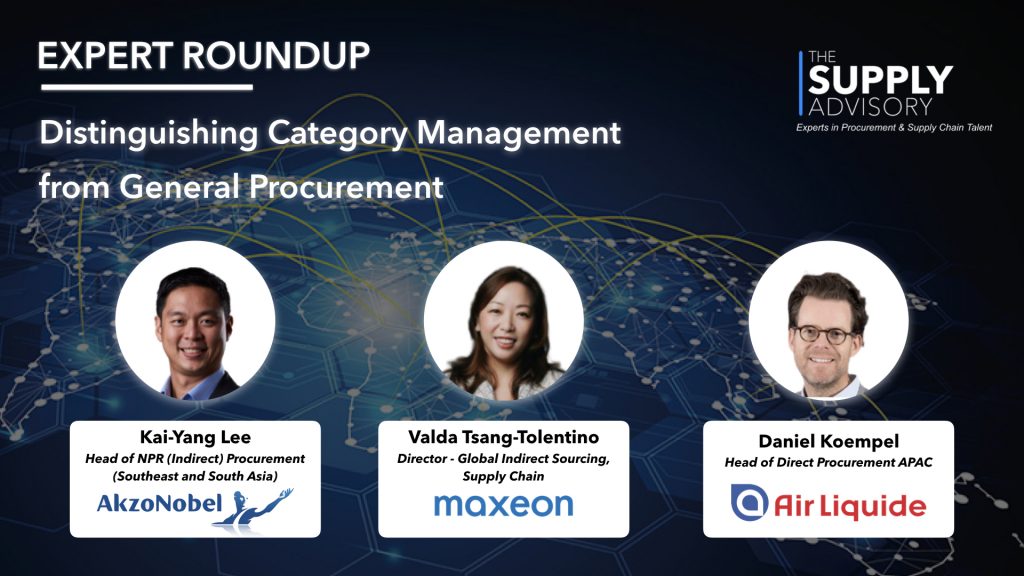
The topic of this edition might sound simple yet is very crucial in the transforming world of procurement.
Given the nature of my work, I get to interact with a large number of procurement professionals from multiple industries and of various levels of seniority. In the last couple of years I see more and more companies embarking on the journey of moving from traditional procurement to category management.
In fact, I had previously done a blog on the hiring trends for 2021 (Ref: https://supplyadvisory.com/talent-hiring-trends-for-2021-supply-chain-procurement/) and Category Management roles featured in that. As you can imagine, Category Management plays a pivotal role in procurement as it aims to use a long-term and strategic approach.
Unlike general procurement, Category Management looks into several factors like the projected budget demands for a specific time frame, the volume of products or services needed, and the logistics cost. It also considers the company’s goals to come up with a cohesive and effective strategy. Category management can also extend beyond sourcing products or services.
Procurify shares that a successful category management strategy also has specific prerequisites. Most of these aren’t required in strategic sourcing. Some examples of which include:
- Analysis of market data and organizational spend
- Pricing analysis of local and foreign suppliers
- Performance rating of potential suppliers
- Analysis of savings acquired from compliance, substitutions, and negotiations
However, it’s no secret that from time to time quite a few procurement professionals – both budding and experienced – confuse some concepts that strictly apply to category management and loosely use them in the general procurement parlance.
To give us a more precise grasp of the subject, I invited three esteemed Regional / Global Procurement Leaders from a range of industries (Renewable Energy, Gases, Chemicals) to share their thoughts. I had asked them the question:
“What are the top 3 distinct aspects of category management that make it stand out from general procurement yet are often loosely used /misconstrued in general procurement parlance?”
Without further adieu, let’s check out their answers below.
Kai-Yang Lee
AkzoNobel
Head of NPR (Indirect) Procurement (Southeast and South Asia)
Distinct Aspect 1 – Proactivity
Category managers now cannot expect to just participate in sourcing projects initiated by internal stakeholders. Category Managers must have unique expertise in their category through external research and network to come up with the best category strategies. They then need to proactively take these strategies to internal stakeholders on how to best structure the need through strategic sourcing and conclude the best commercial and quality outcomes. Managing difficult conversations with multiple stakeholders with differing goals will always be challenging, yet expected of. Herd the cats.
Distinct Aspect 2 – Consolidate, Standardise, Optimise
The traditional thinking on procurement is to consolidate (everything) into a small number of suppliers to drive cost savings. This is only step 1. More value can be unlocked really through standardising specifications in partnership with internal experts and external providers, which often can only be done when the services are outsourced. Once standardised, “brutal” optimisation will be the final key to take out excesses. Category managers need to now take the wheel.
Distinct Aspect 3 – Embrace and Seek Change
Roles of category managers change dramatically every few years. Expectations of procurement, information sources, procurement systems and processes are almost completely different now compared to ten years ago. Further evolutions of corporate procurement are expected. Think Amazon, can corporate procurement be as seamless as personal shopping? The rise of aggregators such as Skyscanner or hotels.com is now changing travel procurement, moving away from direct deals with TMCs, airlines and hotels. Evolve and survive.
Valda Tsang-Tolentino
Maxeon Solar Technologies
Director – Global Indirect Sourcing, Supply Chain
Category Management is an intentional and holistic approach. By segmentation of spend, it is about developing a deep understanding of the market- market conditions, the product offerings, suppliers and the supply chain so that value drivers are clearly identified and pursued with focus.
Category Management is about adopting a longitudinal view. It allows a relational rather than transactional approach to suppliers. It creates a platform for two-way dialogue, market intelligence and supplier changes to be iteratively considered into strategy development and execution. Opportunities (not just cost) in areas such as innovation, sustainability and community can be more readily pursued and sustained over time.
Category Management requires a much broader skill set than traditional procurement. Aside from procurement fundamentals, the ability to develop strategy, manage limited resources and execute plans under dynamic, changing business objectives is essential. Having a deep understanding of the business, developing strong personal networks is also key to positioning category management’s ability to create value in new untapped areas beyond procurement’s scope. Strong communication, influencing, negotiating, story-telling and change management skills are also must-have attributes. Finally, being digital savvy will help to enable future-readiness both personally and functionally as procurement evolves through its digital evolution.
Daniel Koempel
Air Liquide
Head of Direct Procurement APAC
1st aspect: Domain Knowledge Expertise
The globalisation and complexity of the products & services we buy demand an in-depth understanding of our needs, our existing and potential future supply base, its associated market dynamics and underlying supply chains. It is the thorough understanding of the aforementioned elements and its interdependencies that will help us to identify the value levers that help to optimize the spend of our company’s ever increasing global and often highly decentralized operational footprint. The ability and expertise to have a holistic view on the category across the entire supply chain from S2C to P2P is what differentiates “Category Management” from “General Procurement”.
2nd aspect: Sustainable Value Delivery
Category Management is the ability to deliver more than just a one-off price improvement. It is in fact the ability to develop and describe a strategic roadmap that depicts how procurement in collaboration with other functions is able to optimize the category end-to-end. The strategic focus inherent to the work of category management integrates short, medium and long term actions and opportunities that will allow for a continuous optimisation and delivery of bottom line value to the business. It is the category manager’s license to operate.
3rd aspect: Critical Business Partner
The aforementioned domain knowledge expertise paired with the ability to identify & deliver sustainable bottom line value will create the critical business partner status of category management. If done right, as a category manager you become more than just a simple service provider who is called in to deliver a distinct task related to the purchase of a product or service; your insights and knowledge over and above the simple commercial aspects of your category will own you the right to have a seat at the table in order to optimize the entire system. As a category manager you are in fact one of the few individuals in a company that is able to understand the commercial, legal, technical and operational aspects of your category and hence is seen as a critical business partner.
When it comes to creating procurement strategies, organisations have an entire library of tactics and practices to choose from. Category management and general procurement are just two examples of the most commonly used strategies.
Understanding the key distinctions between them not only eliminates confusion but also ensures that your organisation uses the right approach. Hopefully, our expert roundup has cleared up the commonly misunderstood concepts in category management and general procurement.
Again, our team at The Supply Advisory would like to extend our gratitude to our Kai-yang, Valda, and Daniel for carving out time to discuss their thoughts on the topic. Thank you so much!
Make sure to look out for updates at The Supply Advisory Blog to gain more expert insights and join exciting discussions on various Supply Chain Management topics.

Ananya Sinha Roy is the Director at The Supply Advisory (a division of Datasearch Consulting), a leading executive recruitment firm specialising in Procurement & Supply Chain.
You can view the The Supply Advisory website or contact them directly at info@supplyadvisory.com for a more detailed discussion.


